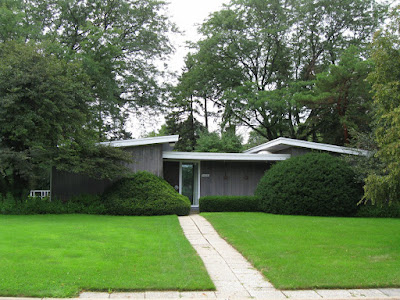On my August vacation, I also spent a few days in my home town, a small city about an hour west of Chicago. Driving around the day before this run, I noticed how may interesting ranch-style houses there are in my old neighborhood. These houses didn't register as anything special when I was growing up—they were just what newish Midwestern suburban houses looked like back then. But that was before I moved to the Northeast, where ranches are rare. And it was before the housing boom, which turned builder-designed McMansion tracts into the default for suburban housing. And maybe I'm also under the spell of
Mad Men's midcentury swankitude. In any case, these houses suddenly look stylish and sophisticated in a way my 17-year-old self would have considered impossible in a place like Aurora, Illinois.
In addition to the ranches, there's a Frank Lloyd Wright house and an internationally famous house by the architect Bruce Goff, known locally as the Round House. It was photographed by
Life magazine in 1951; check out this
amazing interior shot. It was built for an artist named Ruth Van Sickle Ford and the neighbors hated it: At one point, according to
this bio, she put up a sign on the lawn that said, "We don't like your house, either." My neighborhood also has several examples of something more humble, yet positively Space Age: prefab steel
Lustron homes, clad in powder blue enamel tiles.
I don't think I'd like the ranch to make a comeback as a model for new houses. As
this article by Witold Rybczynski suggests, the ranch is a creature of automotive sprawl: You needed a lot of land to build a relatively small house. But compared to today's suburbia, the ranches are refreshingly grown-up homes They're built to house a family, not a family plus the maximum amount of stuff one can haul back from Costco. Rybczynski says they "lacked traditional domestic status symbols, such as porticoes and tall gables," signifying an openness to new ideas, and even some social modesty. I'm romanticizing a bit, of course. The main reason
houses like this weren't built until the 1980s was that people couldn't afford them yet.
 |
The whole package: Ranch house, Airstream RV,
wood-paneled station wagon, aerial antenna. |
|
| From midmodern |
 |
| I bet there's a big Zenith in the living room. |
|
| From midmodern |
























There is a modern ranch house design which differs in some important ways from the interesting designs you've pictured here, and the more cookie cutter ranch style of the 1970s.
ReplyDeleteMost new subdivisions now will have a wide variety of two-story houses, usually with integrated two (and three) car garages, and of sizes ranging from 1200 sq ft to 4000 sq ft. And one ranch style, which is never built as a model, and for which there are only a tiny handful of lots available.
The ranch style of today is a great room in the center, with a high cathedral ceiling over family room/dining room/kitchen. Bedrooms and bathrooms are off to the left and right, with a patio in back.
The cathedral ceiling right in the middle allows the peak of the roof to be almost as high as the peaks of the neighboring two-storys. This allows those porticos and tall gables to make their appearances on the ranch houses, too.
I lived in the Ford house for 7 years, growing up in the 80's. I just returned from a week long stay at the house, doing research for a project. I went on a run with almost the exact same route as yours--before seeing this post--and had the same exact thought about the architecture in that neighborhood. I couldn't believe how many interesting modern houses were built there. When I got back this week from my visit, I was searching online for images of the Goff house from Life Magazine and found your blog. A nice coincidence.
ReplyDelete